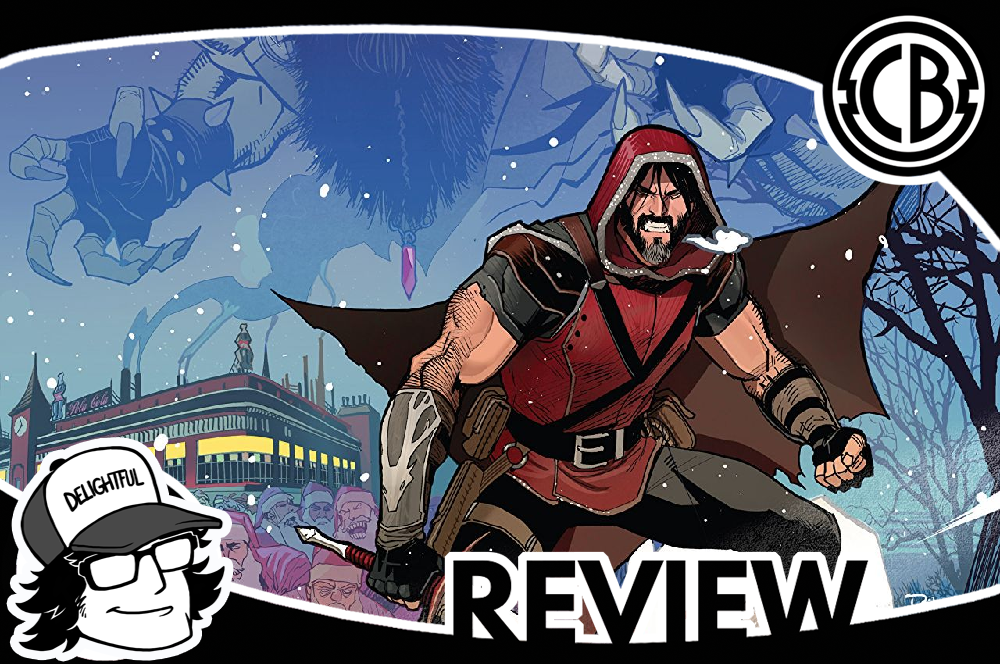Review: Klaus and the Crisis in Xmasville #1
By Jonathan Edwards
On December 5th, 2016, I finally did what I’d spent the better part of the year thinking about doing; I applied to be a comic reviewer for ComicBastards.com. On December 12th, 2016, I received an email inviting me onto the team, and on December 21st, 2016, my reviews for Dept. H #9 and Klaus and the Witch of Winter were published on the site. And now, just barely a year after I sent in my application, here I am reviewing the next Klaus book, Klaus and the Crisis in Xmasville. And, maybe there would have been more ceremony in reviewing next week’s Dept. H #21. Especially since that was the actual first book I reviewed, and issue #21 comes out closer to the anniversary of when I actually reviewed issue #9. But, Klaus only comes one a year, so I think that makes it the more appropriate choice. Also, I could just do both, but I haven’t read an issue of Dept. H despite continuing to buy them with the intention of eventually sitting down and binging them. But until then, let’s focus on Grant Morrison’s superhero Santa Claus.
We start this second annual one-shot in the ‘80s, where a family, after getting themselves lost on the way to a birthday dinner, find themselves in the eponymous Xmasville. There, every day is Xmas (which is considered to be both distinct from Christmas as well as secular), the men are all militant Santas, the women work in a factory, and the children are traded to aliens that feed off of imagination for weapons. Yep. We soon find out that Xmasville is owned by the Partridge Family (the in-universe owners of Pola Cola, not the TV characters) and is part of their latest and greatest attempt to win the war they’ve been waging against Klaus for sole ownership of the holiday season. Furthermore, they’ve outsourced day-to-day operations to a dark universe counterpart of Klaus’s that is eventually referred to as “the Bad Santa” (he also kind of looks like Lobo). As far as premises go, this might be the most insane of all the currently existing Klaus books. Unfortunately, that doesn’t translate into the best story here. It’s not bad, but it does end up feeling a tad unfocused at times, and Klaus doesn’t get quite as much to do.
That being said, I’ve personally found the high point of reading this series to be seeing exactly how Morrison incorporates various figured and concepts from winter folklore and mythology. And in that regard, Crisis in Xmasville still finds some success. In particular, Grandfather Frost is a fascinating inclusion. In Witch of Winter, we saw life-sized wooden figures mocked up to look like different cultural representations of Santa Claus. Among them was the Slavic Ded Moroz AKA Old Man or Grandfather Frost, and I figured that meant each figure was meant to represent a different costume and period in Klaus’s life and career. However, the fact that he is his own entity here suggests that those figures were actually replicas of the multiple co-existing Santas that were either inspired by Klaus or empowered in the same way he was. That’s super cool. Additionally, I believe there’s a solid argument in suggesting Klaus is analogous to Superman, but I think there’s an even better argument for Grandfather Frost as Batman. The interior of Frost’s ice castle is the spitting image of the Batcave, he has a single predominate area of influence (i.e., Russia is his Gotham), and he even has a capable sidekick in the form of his traditional companion Snowmaiden. Admittedly, it’s a bit of a stretch, but I’d be hard-pressed to believe that any of the Frostcave’s familiarity was unintentional.
Of course, Dan Mora is back to handle the art, and as far as I’m concerned, the man can do no wrong. He is simply an exceptional artist that provides consistently exceptional work. And, this one-shot showcases how differently uniquely he can depict different characters as well as letting him play with something of a watercolor a couple of pages. Yet, I’m personally most drawn (pun not intended but acknowledged) to his design of, once again, Grandfather Frost. I love how similar he and Klaus look while still having a number of distinguishing details. What’s more, in the first and only full body shot we get of him, Frost has a glowing hammer in his belt, and a larger, presumably stone, ice, or metal, version of it lies on the ground next to him. It’s a small detail that seems to have no relevance to anything, but perhaps that’s why I’m so curious about its presence. Could it just be a random detail that Mora opted to include for aesthetic purposes? Yes, absolutely. But knowing Morrison, I can’t help but feel like it’s just as likely that there is a specific motivation for it. I even have a theory or two, but it’d take quite a bit more time for me to explain them, and some very, very tangential information would be involved.
As someone who’s been reading since the first issue of the original series, I enjoyed Klaus and the Crisis in Xmasville. And really, other people like that are the ones I’d mainly recommend this to. If you haven’t read either of the other Klaus books, I don’t think this is the best jumping on point. In addition to the prohibitive price, it frankly feels far more geared toward returning readers than new ones. But hey, if you really want to check this one out, and I’m the only dissent on the matter, then screw what I say.
Score: 3/5
Klaus and the Crisis in Xmasville #1
BOOM! Studios


